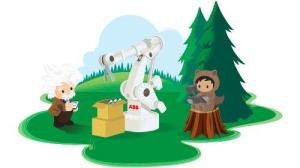The evolution of the global internet has resulted in virtual connections that affect real-world objects and activities. Everything is connected to everything else, creating a distributed ecosystem that reaches far beyond the interconnectivity of things. This is known as the Internet of Everything.
Though the Internet of Everything arose from the Internet of Things, it has become a dynamically evolving phenomenon that is poised to disrupt the business world.
What is the Internet of Things?
Although the term was coined back in 1999, the Internet of Things has undergone a dramatic transformation in the past 20 years. Just a few decades ago, people were connected to each other and the world through landline telephones, televisions and radios, which offer a limited and one-way experience. You could listen and watch, but no interaction with a television or radio.
Home computers ushered in changes that connected people through dial-up internet and a now-antiquated infrastructure. Eventually, DSL replaced dial-up, landlines gave way to mobile phones, and then smartphones and desktops were replaced by laptops and tablets.
Now, nearly everyone in the developed world is connected to the internet through one or more devices. Eventually, internet connectivity moved beyond devices designed for the internet, such as mobile phones, to objects like vehicles, watches, washing machines and healthcare monitors.
Known as the Internet of Things, the interconnectivity of all these Internet-enabled devices opened up a world of possibilities. With embedded technology, the devices can communicate with each other or the internet, and connected devices in automated systems can gather information and analyse it to help organisations gain insights for actionable results.
What is the Internet of Everything?
The Internet of Everything is based on the idea of all-around connectivity, intelligence and cognition. Unlike computerised devices that rely on intelligent internet connections, any object can be fitted with digital features and connected to a network of other objects, people and processes, with the goal of converting information into actions for new capabilities and experiences.
The Internet of Everything’s pillars are:
- Decentralisation: Data is processed in numerous distributed nodes, and not within a central system.
- Data input and output: External data can be stored on devices and returned to other components within the network.
- Connection to every technology in digital transformation: The Internet of Everything connects to cloud computing, artificial intelligence, big data, the Internet of Things, machine learning and other vital future technologies.
The constituent elements of the Internet of Everything are:
- People: People offer personal insights through connected devices, such as healthcare sensors, social media, artificial intelligence, and other technologies analyse the data to discover insights about human concerns and deliver personalised content that’s relevant to their needs.
- Things: Things encompass the Internet of Things or the physical objects with sensors that generate data and transfer it through the network.
- Data: Data from devices is raw, but once aggregated and analysed it can be used for actionable decisions and intelligent solutions.
- Processes: Processes are based on other current technologies, such as social networking, machine learning and artificial intelligence to provide relevant information to a particular person. In this way, the Internet of Everything maximises the potential of big data.
The primary components of the Internet of Everything are hardware, software and services.
Internet of Things vs Internet of Everything
Though they’re often intertwined and some aspects of their evolution occurred together, it’s important to understand the differences between the Internet of Things and the Internet of Everything.
The primary difference between the Internet of Things and the Internet of Everything is the pillars of the concepts:
- The Internet of Things focuses on physical objects.
- The Internet of Everything focuses on four constituents: people, things, data and processes.
Simply put, the Internet of Things involves the interconnectivity of physical objects and data input and output, while the Internet of Everything is a comprehensive term that refers to the interconnectivity of various technologies, processes and people.
Despite these differences, they share some similarities:
- Decentralisation: Both are distributed and don’t operate within a centralised system, giving them independence.
- Security: Distributed systems are vulnerable to cyberattacks and breaches, though decentralisation ensures that the entire system and its connected devices aren’t compromised if problems occur in specific areas.
Examples of the Internet of Things and the Internet of Everything
Marketing Cloud is integrated with Honeycomb, Centrica Connected Home’s custom IoT platform, which provides a range of insights into customer journeys and behaviours.
The Internet of Things has become a part of our daily lives. It includes connected and ‘smart’ devices, such as:
- Vehicle telematics
- Voice-controlled home assistants
- Fitness trackers
- Air-quality monitors
The Internet of Everything expands on these common uses and offers applications for every industry. Here are some examples:
- Manufacturing can use sensors for predictive maintenance and equipment monitoring to reduce downtime and costs from inefficiencies.
- Municipalities can use smart meters for electricity and water monitoring in residential and commercial buildings to monitor usage and look for ways to reduce costs.
- Logistics companies can use sensors and devices on delivery trucks to optimise delivery schedules and routes for cost reduction and customer satisfaction.
KONE is also working with Salesforce Einstein and IBM Watson IoT to create a single, end-to-end system for KONE technicians that will detect equipment problems and generate automated work orders within Salesforce.
Looking to the future
The capabilities and applications for both the Internet of Things and the Internet of Everything are growing, with both moving toward full interconnectivity. As we move toward this new future and its dramatic changes to business processes, we can expect improved products and services that better serve the interests of both stakeholders and consumers.
Explore the world of IoT by building a use case with the Salesforce Platform.








